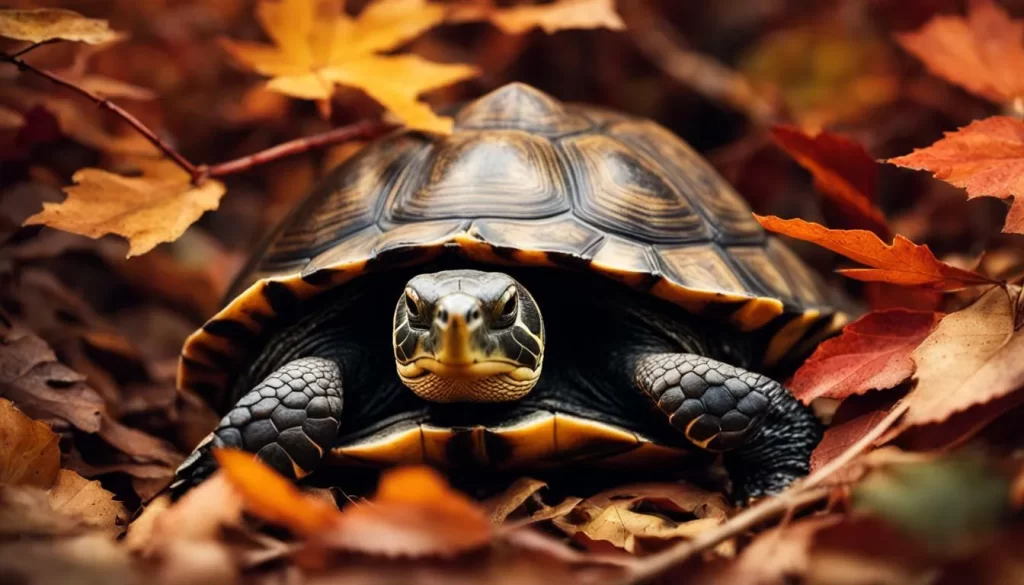If you’ve been wondering why your turtle keeps trying to escape its tank, there are several factors that could be contributing to this behavior.
Turtles are curious creatures, and their natural instincts can drive them to explore beyond their confined spaces.
However, continuous escape attempts can indicate underlying issues that need to be addressed for the well-being of your turtle.
Understanding the reasons behind your turtle’s escape attempts is crucial in providing a suitable environment that meets its needs.
Factors such as an unsuitable habitat, lack of hiding spaces or basking areas, dirty water, stress, improper diet, temperature imbalances, and reproductive instincts can all contribute to a turtle’s desire to escape.
Creating a turtle-friendly environment involves ensuring the tank is the right size, providing enough hiding spaces and basking areas, and maintaining clean water.
Monitoring water parameters, adjusting temperature settings, and offering a proper diet are essential in preventing stress and promoting a healthy behavior in your turtle.
- Turtles may attempt to escape their tank due to various reasons such as an unsuitable habitat, lack of hiding spaces or basking areas, dirty water, and stress.
- Improper diet and temperature imbalances can also contribute to escape attempts.
- Providing a turtle-friendly environment involves ensuring the tank is the right size, offering sufficient hiding spaces and basking areas, and maintaining clean water.
- Monitoring water parameters, adjusting temperature, and providing a proper diet are crucial for preventing stress and escape attempts.
- Reducing stressors and placing the tank away from potential stressors can also help discourage escape behavior in turtles.
Understanding Turtle Behavior
Turtles, like any other animal, have unique behaviors that provide insights into their needs and preferences.
Understanding turtle behavior is crucial for creating a harmonious and enriching environment for these fascinating creatures.
By recognizing their natural instincts and behaviors, you can better cater to their needs and minimize their desire to escape their tank.
One common behavior exhibited by turtles is their curiosity. Turtles are naturally inquisitive creatures that enjoy exploring their surroundings.
This curiosity can sometimes lead to escape attempts as they try to venture beyond the confines of their tank.
To satisfy their need for exploration, it is essential to provide ample enrichment within their enclosure, such as tunnels, branches, and toys.
These items not only stimulate their minds but also provide opportunities for physical exercise, reducing their inclination to escape.
Another significant behavior to consider is the desire for hiding spaces and basking areas. Turtles require both areas to feel secure and comfortable.
Hiding spaces mimic their natural habitat, where they can retreat when feeling stressed or threatened.
Basking areas, on the other hand, provide them with a spot to regulate their body temperature and absorb essential UV rays.
Without these essential elements in their environment, turtles may become stressed and attempt to escape in search of a more suitable habitat.
| Common Turtle Behaviors | Description |
|---|---|
| Shell wiggling | Turtles may wiggle their shells as a way to explore their surroundings or ward off predators. |
| Basking | Turtles require access to a basking area to regulate their body temperature and absorb UV rays. |
| Hiding | Having hiding spaces allows turtles to retreat when feeling stressed or threatened. |
| Exploration | Turtles have a natural curiosity and need stimulation through exploring their environment. |
Additionally, it is crucial to maintain a clean and well-maintained tank environment. Dirty water and poor water quality can lead to stress and health issues for turtles, prompting them to seek an escape route.
Regular water changes, proper filtration systems, and monitoring of water parameters such as temperature, pH, and ammonia levels are essential to prevent these escape attempts.
In summary, understanding turtle behavior is key to preventing escape attempts. By providing enrichment, including hiding spaces and basking areas, maintaining a clean environment, and monitoring water parameters, you can ensure your turtle feels satisfied and content in its tank.
Remember, these behaviors are innate to turtles, and addressing their needs will promote their overall well-being.
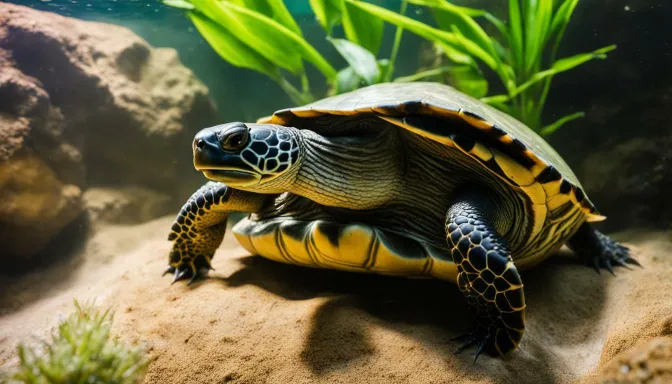
If your turtle’s enclosure does not meet its habitat requirements, it may feel the need to escape in search of a more suitable environment.
Turtles have specific needs when it comes to their living space, and failure to provide these essentials can lead to escape attempts.
One common reason for escape attempts is an enclosure that is too small. Turtles need enough space to swim, explore, and exercise.
A cramped tank can cause stress and frustration, prompting them to seek freedom outside their confinements. Make sure to choose an enclosure that is appropriate for your turtle’s species and size.
| Requirements for a Suitable Turtle Habitat |
|---|
| Ample swimming space |
| Land area for basking |
| Proper filtration system |
| UVB lighting for vitamin D synthesis |
In addition to space, turtles require a land area where they can bask under a heat source. This land area provides them with the warmth they need to regulate their body temperature and aids in digestion.
Without a proper basking area, turtles may become restless and attempt to escape in search of a suitable spot to warm up.
It’s important to note that each turtle species has specific habitat requirements, so research and understanding your turtle’s needs is crucial.
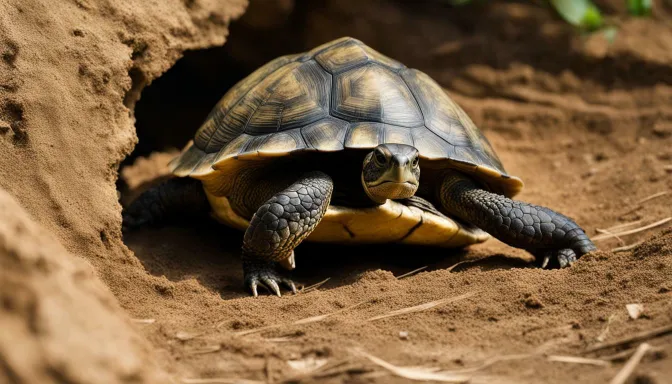
Providing a suitable habitat not only prevents escape attempts but also promotes the overall health and well-being of your pet.
Ensure that the enclosure has proper filtration to maintain clean water, as dirty water can also lead to stress and escape attempts.
Monitoring water parameters regularly is vital to keep your turtle happy and secure.
- Turtles may attempt to escape if their enclosure does not meet their habitat requirements.
- An enclosure that is too small can cause stress and frustration.
- Provide both swimming space and a suitable land area for basking.
- Ensure the enclosure has a proper filtration system to maintain clean water.
- Monitor water parameters and adjust as necessary.
- Research and understand the specific needs of your turtle species.
Lack of Hiding Spaces and Basking Areas
Turtles require hiding spaces and basking areas to feel secure and regulate their body temperature, so the absence of these can trigger escape behavior.
In the wild, turtles have natural hiding spots such as rocks, fallen logs, and dense vegetation where they can retreat and feel safe.
In a turtle enclosure, it is essential to replicate this natural environment by providing suitable hiding spots.
This can be done by adding caves, tunnels, or even artificial plants that create cover and mimic their natural habitat.
Additionally, turtles need basking areas where they can climb out of the water and expose themselves to heat and light.
Basking is crucial for their thermoregulation and overall health. Without a proper basking area, turtles may feel stressed and seek ways to escape in search of a suitable spot.
Ensure that the basking area is easily accessible, large enough for the turtle to comfortably rest, and equipped with a heat source, such as a heat lamp or heating pad, to maintain the required basking temperature.
Table 1: Recommended Hiding Spaces and Basking Areas for Common Turtle Species
| Turtle Species | Recommended Hiding Spaces | Recommended Basking Areas |
|---|---|---|
| Red-Eared Slider | Large rocks, logs, and artificial caves | Basking platform with a heat lamp |
| Box Turtle | Half logs, dense foliage, and tunnels | Flat rocks with sunlight exposure |
| Painted Turtle | Underwater hiding spots, aquatic plants | Basking dock with UVB light |
By providing adequate hiding spaces and basking areas that cater to your turtle’s species-specific needs, you can create a more comfortable and secure environment, reducing the likelihood of escape attempts.
Dirty Water and Poor Water Quality
Turtles are highly sensitive to water conditions, and if their tank is dirty or the water quality is poor, they may try to escape in search of cleaner and healthier water.
The accumulation of debris, uneaten food, and waste can lead to the growth of harmful bacteria and algae, which can adversely affect a turtle’s health.
Additionally, poor water quality can cause skin and respiratory problems, further prompting escape attempts.
To prevent turtles from trying to escape due to dirty water and poor water quality, regular tank maintenance is essential.
It is recommended to perform partial water changes at least once a week, removing approximately 25-30% of the water and replacing it with fresh, dechlorinated water.
Use a water conditioner to neutralize harmful chemicals like chlorine and chloramine.
| Water Parameters | Ideal Range |
|---|---|
| pH | 6.8-7.4 |
| Temperature | 75-80°F (24-27°C) |
| Ammonia (NH3/NH4+) | 0 ppm |
| Nitrite (NO2-) | 0 ppm |
| Nitrate (NO3-) |
Regularly test the water parameters using an aquarium test kit to ensure they remain within the appropriate range. High levels of ammonia, nitrite, or nitrate can indicate a problem with water quality.
If any of these parameters are elevated, take immediate action to rectify the issue by adjusting filtration systems, performing additional water changes, or seeking advice from a veterinarian.
Providing a Clean and Healthy Environment
- Remove uneaten food, feces, and debris promptly using a fish net or siphon.
- Use a reliable filtration system appropriate for your tank size to mechanically and biologically filter the water.
- Consider adding live plants to the tank, as they can help absorb excess nutrients and improve water quality.
- Avoid using chemicals or harsh cleaning agents when cleaning the tank or equipment, as they can be toxic to turtles. Instead, use only warm water or a mild, turtle-safe cleanser.
By maintaining a clean and healthy environment, you can minimize the risk of escape attempts caused by dirty water and poor water quality.
Remember to observe your turtle regularly for any signs of distress or illness and seek professional advice if needed.
Providing optimal water conditions is crucial for the overall well-being and happiness of your turtle.
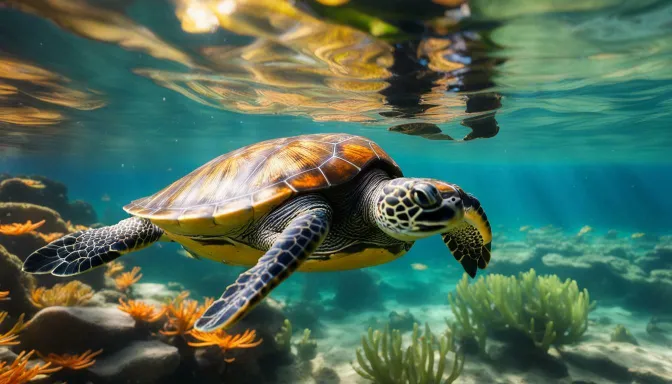
Stress from various sources, such as loud noises, excessive handling, or the presence of predators, can cause turtles to become anxious and attempt to escape.
Turtles are naturally sensitive creatures, and any disturbance to their environment can trigger stress and lead to escape behavior.
It is essential to create a calm and secure space for your turtle to minimize stressors and prevent escape attempts.
One common stressor for turtles is noise. Loud sounds from household appliances, construction work, or even loud conversations can startle turtles and make them feel threatened.
To reduce noise-related stress, consider placing your turtle’s tank in a quiet area of your home, away from noisy appliances or high-traffic areas.
Another stress factor is excessive handling. Turtles are not fond of constant handling or physical disturbances.
Frequent handling can cause them to feel insecure and provoke escape behavior. While it’s important to interact with your turtle and provide necessary care, limit handling sessions to avoid overwhelming your pet.
Predators, even if they are not directly present, can also be a source of stress for turtles. The mere presence of perceived threats, such as other pets or wild animals, can cause distress and trigger an escape response.
Ensure that your turtle’s tank is placed in a safe location, away from potential predators, to provide a sense of security and peace.
| Stress Factors | Prevention Measures |
|---|---|
| Noise | Place the tank in a quiet area of the house |
| Excessive handling | Limit handling sessions and provide a secure hiding spot |
| Predators | Keep the tank away from potential threats |

By understanding and addressing the stress factors that can affect your turtle’s behavior, you can ensure a calm and secure environment that minimizes the risk of escape attempts.
Remember, a stress-free turtle is a content and happy turtle.
Improper Diet and Nutrition
Inadequate nutrition can affect a turtle’s overall well-being and may prompt escape behavior as it searches for alternative food sources.
A balanced and appropriate diet is crucial for maintaining a healthy turtle and reducing the likelihood of escape attempts.
Turtles are omnivorous creatures, meaning they require a combination of plant and animal matter to meet their dietary needs.
Commercially available turtle food can serve as a base diet, but it should be supplemented with a variety of fresh vegetables, fruits, and protein sources.
Leafy greens, such as kale and collard greens, are excellent sources of vitamins and minerals for turtles.
It is important to avoid overfeeding or underfeeding your turtle, as both can have negative consequences.
Overfeeding can lead to obesity and other health problems, while underfeeding may cause a turtle to become malnourished and more prone to escape attempts. Monitor your turtle’s weight and adjust the feeding portions accordingly.
| Key Points | Tips for Turtle Care |
|---|---|
| Provide a balanced diet | Offer a combination of commercial turtle food, fresh vegetables, fruits, and protein sources. |
| Avoid overfeeding or underfeeding | Monitor your turtle’s weight and adjust feeding portions accordingly. |
| Ensure proper supplementation | Consider using calcium and vitamin supplements to fulfill your turtle’s nutritional requirements. |
| Consult a veterinarian | If you are unsure about your turtle’s dietary needs, seek advice from a reptile veterinarian. |
Additionally, offering calcium and vitamin supplements can ensure your turtle receives the necessary nutrients.
This is particularly important for turtles that are not exposed to natural sunlight, as they may have a higher risk of vitamin D deficiency.
If you are uncertain about your turtle’s dietary needs or have concerns about its nutrition, it is always advisable to consult a veterinarian with expertise in reptile care.
They can provide personalized recommendations based on the specific needs of your turtle.
Temperature Imbalances
Turtles are ectothermic creatures and rely on external heat sources, so if the temperature in their tank is too high or too low, they may try to escape to find a more suitable environment.
It is crucial to maintain the correct water and basking area temperatures to ensure the well-being of your turtle and prevent escape attempts.
To create a suitable temperature gradient, use a reliable thermometer to monitor the water and air temperatures in the tank.
For most turtle species, the water temperature should be kept between 75-85°F (24-29°C), while the basking area temperature should range from 85-95°F (29-35°C).
Provide a heat lamp or heating pad to ensure consistent and appropriate temperatures.
Keep in mind that different species of turtles may have slightly different temperature requirements, so research your specific turtle’s needs.
It is also essential to avoid rapid temperature fluctuations, as this can cause stress and discomfort for your turtle, potentially leading to escape attempts.
Additionally, consider placing the turtle tank away from direct sunlight or drafty areas, as these factors can also impact temperature stability.
Regularly check the water and air temperatures using a thermometer to ensure they remain within the appropriate range.
Adjust heating equipment as needed to maintain the optimal environment for your turtle.
| Water Temperature | Basking Area Temperature |
|---|---|
| 75-85°F (24-29°C) | 85-95°F (29-35°C) |
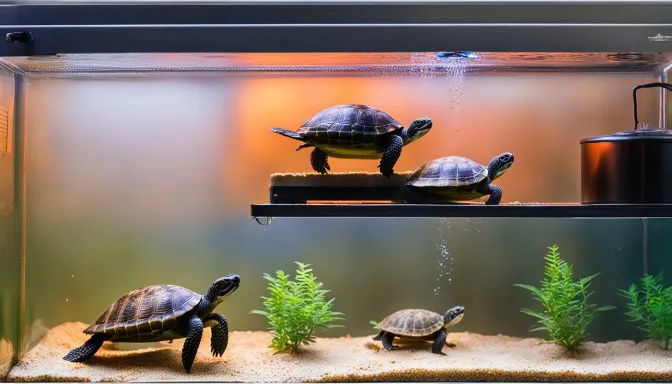
- Turtles are ectothermic creatures and require proper temperature regulation.
- Maintain water temperature between 75-85°F (24-29°C) and basking area temperature between 85-95°F (29-35°C).
- Use a thermometer to monitor temperature levels and make adjustments as necessary.
- Avoid rapid temperature fluctuations and provide a stable environment for your turtle.
By ensuring appropriate temperature regulation in your turtle’s tank, you can minimize the risk of escape attempts and create a comfortable habitat that promotes their well-being.
Pregnancy and Reproductive Instincts
Female turtles, especially those nearing the mating season, may display escape behavior as they seek out suitable nesting sites. It is important to understand that this behavior is driven by their natural reproductive instincts and should be managed accordingly.
During the breeding season, female turtles become restless and may try to escape their enclosure in search of a nesting area. This behavior is a strong instinct that ensures the survival of their offspring. To prevent escape attempts and provide a safe environment for your pregnant turtle, it is crucial to meet her nesting needs within the tank.
Creating a nesting area can be achieved by adding a nesting box or a section of sand within the enclosure. The box or sand should be placed in a quiet and undisturbed area to mimic the ideal nesting conditions in the wild. The depth of the sand should be around 6-8 inches to allow for proper egg deposition.
Additionally, providing ample space and natural hiding spots for your pregnant turtle will help reduce stress and minimize escape attempts. Rocks, logs, and plants can be strategically placed to create a sense of security and privacy. Remember to monitor the temperature and humidity levels within the nesting area to ensure optimal conditions for egg incubation.
Table 1: Tips to Manage Escape Behavior During Pregnancy
| Tip | Description |
|---|---|
| Provide a nesting area | Add a nesting box or sand within the enclosure to meet the nesting needs of your pregnant turtle. |
| Offer hiding spots | Strategically place rocks, logs, and plants to create natural hiding spots for your pregnant turtle. |
| Monitor temperature and humidity | Ensure optimal conditions within the nesting area for proper egg incubation. |
By understanding and addressing the reproductive instincts of your pregnant turtle, you can help minimize escape behavior and provide a conducive environment for successful egg deposition and incubation.
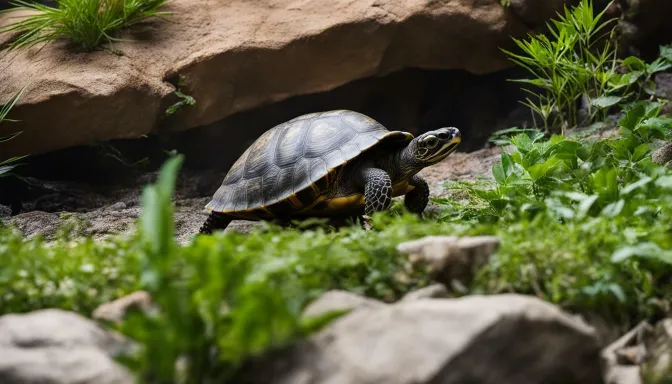
Creating an Escape-Proof Turtle Enclosure
By implementing certain strategies and considerations, you can create a secure and comfortable environment for your turtle, reducing the likelihood of escape attempts. Turtles may try to escape their tank for various reasons, but with the right enclosure setup, you can minimize this behavior and ensure the well-being of your aquatic friend.
First and foremost, it is crucial to provide a tank that is spacious enough for your turtle to move around comfortably. A too-small tank can lead to feelings of confinement, prompting escape attempts. Research the specific needs of your turtle species and invest in an appropriately sized enclosure to accommodate their growth and natural behaviors.
In addition to space, ensure that your turtle’s enclosure offers plenty of hiding spaces and basking areas. Turtles often seek shelter and basking spots to regulate their body temperature and feel secure. Including rocks, logs, and plants will provide them with safe havens and help prevent escape attempts born out of stress or a lack of suitable resting areas.
Final Thoughts
Maintaining clean water is paramount for a healthy turtle habitat and can discourage escape behavior.
Regularly monitor water parameters such as temperature, pH, and ammonia levels to ensure they fall within the recommended range for your turtle species.
Filtration systems should be installed and maintained to keep the water clean and free from harmful substances.
Lastly, consider the placement of your turtle’s tank. Keep it away from potentially stressful stimuli, such as loud noises or direct sunlight exposure, as these factors can significantly impact their behavior.
Opt for a quiet and peaceful area where your turtle can feel safe and secure, reducing the chances of escape attempts caused by stress or curiosity.
FAQ
Q: Why does my turtle keep trying to escape?
A: Turtles may try to escape their tank for several reasons, including an unsuitable habitat, lack of hiding spaces or basking areas, dirty water, stress, and curiosity. A too-small tank, improper diet, improper water temperature or basking area temperature, and pregnancy can also contribute to escape attempts.
Q: What are some common turtle behaviors that can lead to escape attempts?
A: Turtles may exhibit behaviors such as exploring their environment, trying to find hiding spots, basking for warmth, and searching for food. These behaviors can manifest as escape attempts if their needs are not properly met.
Q: How can an unsuitable habitat contribute to escape attempts?
A: An unsuitable habitat can make a turtle feel stressed and uncomfortable. This can lead to escape attempts as the turtle tries to find a more suitable environment with adequate space, temperature, and hiding spots.
Q: Why is it important to provide hiding spaces and basking areas in a turtle’s enclosure?
A: Hiding spaces and basking areas are essential for a turtle’s well-being. They provide a sense of security and allow the turtle to regulate its body temperature. Without these spaces, the turtle may feel stressed and attempt to escape.
Q: How does dirty water and poor water quality contribute to escape attempts?
A: Dirty water and poor water quality can lead to health issues in turtles. This can cause discomfort and stress, prompting the turtle to try and escape the unsanitary conditions.
Q: What are some common stress factors for turtles?
A: Turtles can be stressed by factors such as loud noises, excessive handling, overcrowding, and changes in their environment. Stress can trigger escape attempts as the turtle seeks safety and stability.
Q: How does an improper diet affect a turtle’s behavior?
A: An improper diet can lead to nutritional deficiencies and health problems in turtles. This can result in behavioral changes, including an increased desire to explore or escape in search of better food sources.
Q: How do temperature imbalances influence escape attempts?
A: Turtles require specific water and basking area temperatures to maintain their overall health and well-being. If the temperature is too hot or too cold, turtles may try to escape in search of a more suitable climate.
Q: Can pregnancy and reproductive instincts cause turtles to try and escape?
A: Yes, female turtles may exhibit escape attempts during the breeding season as they seek suitable nesting areas to lay their eggs. This behavior is driven by their natural reproductive instincts.
Q: How can I create an escape-proof turtle enclosure?
A: To create an escape-proof turtle enclosure, ensure that the tank is the right size, provides enough hiding spaces and basking areas, and is kept clean. Monitor water parameters, adjust temperature, and provide a proper diet. Reduce stressors and place the tank away from potential stressors to create a safe and secure environment for your turtle.




